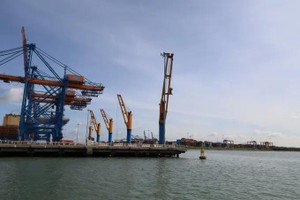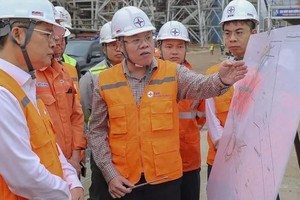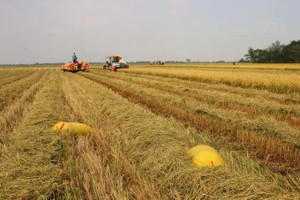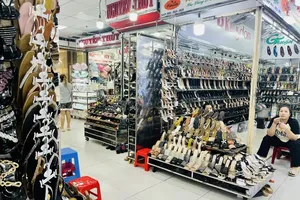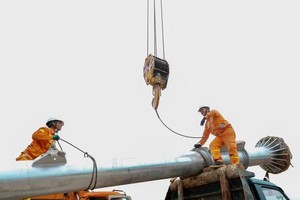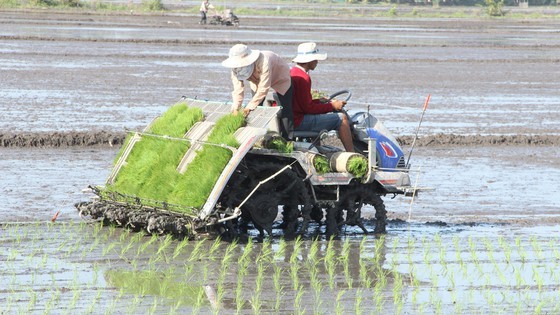
Mr. Thieu Van Hai, Director of Hai Thanh Agricultural Cooperative in Hau Giang Province, and farmers have continued to choose fragrant rice varieties for production. This is also an important highlight of Mekong Delta farmers, opening up opportunities to polish the brand of Western rice.
It is not a coincidence that Mr. Thieu Van Hai was hired by farmers in Chau Thanh A District in Hau Giang Province to be the director of Hai Thanh Cooperative. Mr. Hai has been the pioneer in growing fragrant rice for the past 15 years. With 1.5 hectares of land, the income from fragrant rice is 20-30 percent higher than regular rice varieties, helping him to accumulate to expand the growing area of fragrant rice to 6.6 hectares. Mr. Hai has become a good example for farmers in the cooperative to produce fragrant rice unanimously.
According to the Ministry of Agriculture and Rural Development, in the 2020-2021 winter-spring rice crop, the Mekong Delta region sows over 1.55 million hectares of rice with an estimated output of 10 million tons of rice. It is most likely that in the dry season of next year, saltwater intrusion and drought will come soon and happen severely. Provinces such as Kien Giang, Hau Giang, and Tien Giang, which are heavily affected by saltwater intrusion and drought, must grow rice early to avoid saline intrusion at the end of the crop. More than five years ago, the rate of low-grade rice varieties in the Mekong Delta was quite large in the production structure, when farmers still used the IR50404 rice variety, which accounted for 30-40 percent. During that time, the prices of Vietnamese export rice were always far behind those of Thailand in the market. But now that has changed.
‘High-quality rice varieties currently account for about 80 percent of the growing area, whereas low-grade varieties like IR50404 rice variety only hold less than 8 percent. Noticeably, the proportion of ST rice varieties has risen from 3 percent to 5 percent,’ Mr. Tran Chi Hung, Director of Department of Agriculture and Rural Development of Hau Giang Province, said.
Following Tra Vinh and Dong Thap provinces, farmers in Hau Giang Province are now replicating the smart rice production model. Mr. Tran Van Dang, a member of Hai Huynh Cooperative in Vi Thuy District, is one of the Hau Giang farmers enthusiastically participating in smart rice production. After three crops under this model, Mr. Tran Van Dang said that the smart rice growing model helped him to have more knowledge and understanding of rice-growing techniques to meet the new trend in response to climate change. Profits were higher than conventional rice cultivation from 20-30 percent. His family earned over VND75 million from two hectares of rice last winter-spring rice crop.
Agricultural engineer Ho Quang Cua, the father of the ST fragrant rice varieties, optimistically commented that high-quality rice varieties currently account for 1 million hectares in the Mekong Delta, and the low-grade IR50404 rice variety has gradually shrunk. The ST24 and ST25 rice varieties, which recently won an international award, have covered one-third of the rice-growing area in the Ca Mau peninsula. Nearly one-third of farmers in the Mekong Delta are classified as the best rice farmers in Asia. That is the basis for Vietnamese rice to enhance its position.
The export prices of Vietnamese rice in December this year fluctuates around US$460-US$520 per ton. This is the first time in the past five years, the level of export prices of Vietnamese rice exceeds $450 per ton. It is expected that Vietnam's rice exports will reach 6 million tons this year.
Vietnam's rice exports are at a high level this year, due to many factors, such as the needs of the world market. However, it is important that the quality of rice has been improved and maintained stably, so it can compete with Thai rice, said Mr. Nguyen Trung Kien, General Director of Gentraco Company in Can Tho City.
Looking back on rice exports in 2020, enterprises in the Mekong Delta scored when the EU-Vietnam Free Trade Agreement (EVFTA) officially took effect in August. This is a door opening up many opportunities for Vietnamese enterprises to export to the EU market.
Accordingly, Vietnam's rice products will be exempt from export tariffs to the EU when the EVFTA takes effect. Of which, 80,000 tons of rice will enjoy tax incentives. Some enterprises, such as Loc Troi Group and Trung An High-Tech Agriculture Joint Stock Company, have quickly exported fragrant rice to the EU market. After ST24 rice, ST25 rice received the world's best rice award, creating a certain position for Vietnamese rice in the market. In the domestic market, the price of ST25 rice has reached a fairly high selling price of VND35,000 per kilogram or over $1,000 per ton. Therefore, it is not difficult to understand when the export price of ST rice variety to the EU market is above $1,000 per ton.
With diverse ecological characteristics, the Mekong Delta provides rice products, which satisfy many different segments, including specialty rice, high-quality rice, and rice for the niche market. This is a remarkable advance of Vietnamese rice. As the rice export quotas have been untied over the past years, it has helped more than 100 enterprises to participate in the export market, with many different export segments, creating a driving force for the establishment of raw material growing areas for high-quality and specialty rice.
According to rice experts, if the quality of exported rice is controlled well, shortly, not only will Vietnam's export quotas on the EU market increase, but it will also urge many partners to seek to buy Vietnamese rice. The opportunity to polish the brand is opening up for Western rice.
It is not a coincidence that Mr. Thieu Van Hai was hired by farmers in Chau Thanh A District in Hau Giang Province to be the director of Hai Thanh Cooperative. Mr. Hai has been the pioneer in growing fragrant rice for the past 15 years. With 1.5 hectares of land, the income from fragrant rice is 20-30 percent higher than regular rice varieties, helping him to accumulate to expand the growing area of fragrant rice to 6.6 hectares. Mr. Hai has become a good example for farmers in the cooperative to produce fragrant rice unanimously.
According to the Ministry of Agriculture and Rural Development, in the 2020-2021 winter-spring rice crop, the Mekong Delta region sows over 1.55 million hectares of rice with an estimated output of 10 million tons of rice. It is most likely that in the dry season of next year, saltwater intrusion and drought will come soon and happen severely. Provinces such as Kien Giang, Hau Giang, and Tien Giang, which are heavily affected by saltwater intrusion and drought, must grow rice early to avoid saline intrusion at the end of the crop. More than five years ago, the rate of low-grade rice varieties in the Mekong Delta was quite large in the production structure, when farmers still used the IR50404 rice variety, which accounted for 30-40 percent. During that time, the prices of Vietnamese export rice were always far behind those of Thailand in the market. But now that has changed.
‘High-quality rice varieties currently account for about 80 percent of the growing area, whereas low-grade varieties like IR50404 rice variety only hold less than 8 percent. Noticeably, the proportion of ST rice varieties has risen from 3 percent to 5 percent,’ Mr. Tran Chi Hung, Director of Department of Agriculture and Rural Development of Hau Giang Province, said.
Following Tra Vinh and Dong Thap provinces, farmers in Hau Giang Province are now replicating the smart rice production model. Mr. Tran Van Dang, a member of Hai Huynh Cooperative in Vi Thuy District, is one of the Hau Giang farmers enthusiastically participating in smart rice production. After three crops under this model, Mr. Tran Van Dang said that the smart rice growing model helped him to have more knowledge and understanding of rice-growing techniques to meet the new trend in response to climate change. Profits were higher than conventional rice cultivation from 20-30 percent. His family earned over VND75 million from two hectares of rice last winter-spring rice crop.
Agricultural engineer Ho Quang Cua, the father of the ST fragrant rice varieties, optimistically commented that high-quality rice varieties currently account for 1 million hectares in the Mekong Delta, and the low-grade IR50404 rice variety has gradually shrunk. The ST24 and ST25 rice varieties, which recently won an international award, have covered one-third of the rice-growing area in the Ca Mau peninsula. Nearly one-third of farmers in the Mekong Delta are classified as the best rice farmers in Asia. That is the basis for Vietnamese rice to enhance its position.
The export prices of Vietnamese rice in December this year fluctuates around US$460-US$520 per ton. This is the first time in the past five years, the level of export prices of Vietnamese rice exceeds $450 per ton. It is expected that Vietnam's rice exports will reach 6 million tons this year.
Vietnam's rice exports are at a high level this year, due to many factors, such as the needs of the world market. However, it is important that the quality of rice has been improved and maintained stably, so it can compete with Thai rice, said Mr. Nguyen Trung Kien, General Director of Gentraco Company in Can Tho City.
Looking back on rice exports in 2020, enterprises in the Mekong Delta scored when the EU-Vietnam Free Trade Agreement (EVFTA) officially took effect in August. This is a door opening up many opportunities for Vietnamese enterprises to export to the EU market.
Accordingly, Vietnam's rice products will be exempt from export tariffs to the EU when the EVFTA takes effect. Of which, 80,000 tons of rice will enjoy tax incentives. Some enterprises, such as Loc Troi Group and Trung An High-Tech Agriculture Joint Stock Company, have quickly exported fragrant rice to the EU market. After ST24 rice, ST25 rice received the world's best rice award, creating a certain position for Vietnamese rice in the market. In the domestic market, the price of ST25 rice has reached a fairly high selling price of VND35,000 per kilogram or over $1,000 per ton. Therefore, it is not difficult to understand when the export price of ST rice variety to the EU market is above $1,000 per ton.
With diverse ecological characteristics, the Mekong Delta provides rice products, which satisfy many different segments, including specialty rice, high-quality rice, and rice for the niche market. This is a remarkable advance of Vietnamese rice. As the rice export quotas have been untied over the past years, it has helped more than 100 enterprises to participate in the export market, with many different export segments, creating a driving force for the establishment of raw material growing areas for high-quality and specialty rice.
According to rice experts, if the quality of exported rice is controlled well, shortly, not only will Vietnam's export quotas on the EU market increase, but it will also urge many partners to seek to buy Vietnamese rice. The opportunity to polish the brand is opening up for Western rice.








